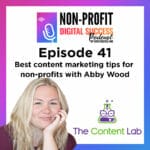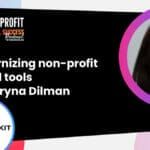Video recording
Audio recording
In this enlightening episode of Non-Profit Digital Success, we reconnect with Abby Wood, celebrated content strategist and digital agency mentor. Discover the power of Artificial Intelligence in revolutionizing non-profit brand and content strategies, helping combat writer’s block and sparking creativity for impactful messaging.
Abby offers invaluable insights into perfecting your non-profit’s brand voice, ensuring consistency across all communication channels. Learn practical steps for developing robust brand guidelines and engaging your audience with authenticity. Don’t miss this opportunity to elevate your non-profit’s presence with expert advice from Abby Wood!
Mentioned Resources
Episode Transcription
David Pisarek: Have you ever needed help with pulling consistent content from multiple departments? We’re ensuring that every content that you create resonates with your non-profit’s unique voice, from tools that elevate your brand assets to creating flawless content calendars.
We’ve got Abby back on the show, and she’s got you covered. Stay tuned, and let’s transform your content.
Welcome to the Non-profit Digital Success podcast. I’m your host, David. In this episode, we’re going to be talking with my good friend, Abby, and having her back on the podcast again.
If you missed the last episode with Abby, I will do a quick intro here. Abby has been a content strategist and copywriter for over 12 years.
She’s the founder of the Content Lab, a copywriting agency, and Content Goodies, providing content templates. She’s also co-founder of Ireland Website Design, a full-service e-commerce agency, and LearnRight, which is an LMS solution. Abby is also a mentor for other digital agency owners.
Abby, welcome back to the show.
Abby Wood: Thank you so much for having me. I’m delighted to be here. What an introduction.
David Pisarek: Yeah, it’s so great having you here.
Let’s just jump in and get started with this. There’s an elephant in the podcast. I’d say the broom, right? Let’s just talk for a quick sec about AI, right? Huge.
Over the last year, year and a half, it’s gotten even with the prevalence of ChatGPT and Bard and this and that and whatever, whatever. What’s your take on it?
Abby Wood: AI has its uses and it has its non-users.
I would definitely say it’s fantastic for radiation. If you suffer with a writer’s blog or you just need a high-level introduction to subject matters, fantastic. Ask away. I know a couple of my friends use it as a free counselling service.
Literally just like, “Hey, AI, what can you tell me about this?” Now, how I’m not sure if you’re familiar with this, but in terms of professional settings, definitely recommend it for ideation. It’s great for coming up with “A list of 10 blog titles” or whatever. I am a little bit biased.
I’m a professional writer, obviously, and I have a team of very talented professional writers, so we are biased, but it’s not great at actually creating content that is publish-ready.
It’s great for doing a first draft. If you’re not particularly comfortable doing a first draft, if you’re stuck staring at that blinking cursor, definitely get AI to get something on the page, but you want to edit it. It’s not great at voice at the moment.
It’s not great at that uniquely human touch that good copy needs. So yeah, it has its uses, and it has its not so great uses.
David Pisarek: We use it in my agency for brainstorming. We do this with our clients as well. We’ve used ChatGPT to come up with topics to do that brainstorming like Abby’s talking about and really kickstarting it to help get the juices flowing, so to speak.
Abby Wood: Absolutely. It’s Fantastic for coming up with ideas.
I know quite a few people use it for proofreading as well, but mixed results, mixed results. It’s like find the errors and rewrite this without spelling and grammatical errors and stuff. But I’ll stick to Grammarly.
David Pisarek: Yeah, and Grammarly does have AI, but that’s for a whole other conversation.
Something you did say, though, is tone and voice. Let’s talk about that because I think it’s really important for organizations to think of brand.
When people think of a brand, they think of logos or colours. You’ve got Nike, Coca-Cola, McDonald’s, or whatever brands you want to follow. You can instantly recall what these logos look like.
But what a lot of people don’t understand the underlying part of the brand is the style, the tone, and the voice of the messaging. What are your thoughts around how people should be thinking about that?
Abby Wood: I think brand is like the perception of your company.
You can think of your company as a brand but also as its own person. It has a brand voice. It has a unique way of talking about itself.
One of the things that I like to do in our workshops is to ask people, “If your brand walked into a room, how would you describe it? Is it attending meetings, wearing flip flops and shorts and a T-shirt, or is it in a three-piece suit?” It’s just those little questions that really make you think outside of just a colour palette because your brand has its own personality.
Voice and tone are a very important element of that. I’m sure we can throw a few slogans out and you instantly know who it is. If tone is wrong, if the voice is wrong for a certain brand, you instantly know it.
You read it, and you’re like, “Oh, that doesn’t sound right. That doesn’t sound like them.” If we take Wendy’s, for example, they are renowned for their social media presence and their cheeky social media statuses and stuff, and that is very on brand. If Wendy came out, well, not actually Wendy.
Wendy isn’t a real person, which I’m quite disappointed about. But if Wendy’s came out and You said something really serious, really serious, very formal language.
We’re talking three-plus syllabi a word. You wouldn’t be taken aback. That isn’t what I was expecting of this fast-food chain at all. It’s the same for non-profits.
If you’re really fun and young and energetic, and then you start talking like a science teacher, no offence to science teachers, just a different type of voice, people will be taken aback and think, “Oh, that doesn’t sound right.”
But yeah, that’s a very quick introduction to voice, I guess.
David Pisarek: One of the things I think that organizations might struggle with is, all right, you’ve got a brand guy, you hired a design agency, maybe it was my agency, just putting that out there a little bit. But you’ve hired an agency or yourself You designed a logo. You’ve created a brand guide for that. You’ve got your primary, secondary, fonts, primary, secondary, tertiary colours, acceptable use of the logo, and all that stuff.
A lot of organizations, even businesses, don’t have anything around a style guide for content.
When we think about our organizations, even if you’re small or medium, your executive team, maybe some volunteers, making sure that everybody’s on the same page, that everybody who needs to create content is creating it in the same way.
One of the things that I like to talk about is having a style guide for your writing. What are your recommendations for getting consistent content and consistency in the tone and style of messaging from various people across an organization? It is tricky.
Abby Wood: It is tricky. A brand messaging guideline, guidelines even, is the best solution that you can really come up with.
A brand messaging guideline document is what language is used and what language isn’t used. It can go as in-depth as you want.
You can have examples of exactly how to write good headlines. You can have examples of literally down to we put full stops at the end of our titles on our website and stuff. Y
ou can be as in-depth as you want. A really useful thing that we include in all of our brand messaging guidelines is a voice tone matrix. You can have, it’s literally just lines of boxes with two opposite words at the end of each and a mark out of five as to where your company falls on the scale.
You can be super traditional or super modern. If you just tick the box, then you give an example of how to write to that particular type of voice, that particular type of positioning. That could be so helpful.
You can give examples of how not to write as well. “We don’t curse or we don’t talk about our clients in a certain way. We only use positive language in everything. We don’t frame things in a negative way.”
Although it may come as natural to you or your team, for anybody that’s incoming into your organization, it’s essential because otherwise, they may come in, and they’re just like, “Oh, I’ll just write it, however.” It’ll be off-brand completely, and you may have to end up redoing it, or you might get a complaint about something that’s been written, or you never know how it goes.
They’re incredibly important, especially if you’re dealing with a lot of volunteers. Quite a few of the non-profits that we’ve worked with, they rely on volunteers to run their social media because it’s quite a time-consuming thing. It is difficult to stay on top of trends and all this stuff.
Some of them before we got the brand messaging guidelines sorted, you could literally go through and just be like, “This person wrote this, this person wrote that, this person wrote this.” Whereas you want it to be consistent, even down to how you spell things.
If you have a UK volunteer and an Australian volunteer and a Canadian volunteer, they’re all going to spell things differently. Of course, the lovely Americans as well, they’re going to spell things differently.
David Pisarek: Like the word colour. There is a U in colour. I will doll you on that hill.
Abby Wood: It’s funny. Even organizations, the S and the Z, one of the most used words on non-profit websites, is spelled differently around the world. It’s so easy to overlook the simple things, but it does damage credibility if it’s not done correctly.
It’s super important, but I would definitely… You can give examples of how to write for social media posts. You can give examples of how to do reports. You can give examples of how not to do stuff as well. Then just hand it out to new teams, old teams, volunteers, everybody.
David Pisarek: I think it’ll be really great if organizations, as part of onboarding, provided the brand guide to new employees.
Even the word non-profit, you spell it as one word, two words are hyphenated. There are different ways. Let’s get on board. Is onboard hyphenated or not? Let’s make sure that everybody understands what we’re expecting of them.
Emails going to, let’s say your organization has an info ad general inbox, and that person who manages that is responsible for replying to inquiries that come in or forwarding them to other people internally.
You want to have a consistent voice across that, especially when you’re dealing with people outside your organization. You mentioned Abby, don’t speak in the negative if that’s part of your style.
I would highly recommend to everybody never speak in the negative.
One of the big culprits is typing at the end of an email, “Don’t hesitate to get in touch with me.” No, that’s two negatives. It’s not good. Instead, write something just as simple as “I look forward to hearing from you” or “Please get in touch with me if you have any questions.” Rephrase it.
One of the things that we do here that I’m guilty of is, using ChatGPT – (let’s try again) One of the things that I’m guilty of, aside from misspeaking, is using ChatGPT to reward things in the positive when I can’t mentally figure it out. Just throw it in and be like, “All right, flip this into a positive.” That’s totally fine. But asking it for 2,000 pages… 2,000 pages? I mean, 2,000 words of content, I don’t think it’s going to turn out to be as good as you expect.
All right, we’re talking about brands, we’re talking about messaging, tone, style. Are there any tools that you would recommend that organizations could look at to create these professional brand assets?
Abby Wood: Absolutely.
I do have a voice tone matrix questionnaire guide thing. If you would like it, please just email me. I’m sure the lovely David is going to provide my email with this podcast. I’m happy to share that It’s what we use in our own agency, and it’s a simple little Google Doc.
You can share it internally with the team and just make sure everyone has access to it. Outside of that, I would keep it as simple as possible.
You can do plenty of (if you have the time, I know everyone is time-strapped, but) you can do research into brand personas. My goodness, that was just… I couldn’t remember that word. I’m so sorry. You can have a look at brand personas, make sure everyone has access to user personas.
I know a couple of agencies that are using ChatGPT to create very thorough user personas for their target market. But yeah, I would say keep it as simple as possible.
Of course, there are plenty of people who use the likes of Canva and stuff to create beautiful guides that look amazing if they’re doing it all in-house.
If they’re using a content agency like mine, then you’ll be provided with documents. But yeah, if this is your first time creating brand messaging guidelines, I always like to collect everything you already have, figure out what you want to keep, what still resonates, and what works, and then discard everything that doesn’t work.
It doesn’t matter if it’s been your mission for the last 25 years. Everything needs updating sometimes. Even just updating core values, mission values, and vision even… Do you know what? You’re not the only one that can’t speak today, David. I am so sorry.
David Pisarek: It’s all good. Nobody listening cares. It’s all good. This is solid advice right here, giving everybody, and that’s what counts.
Abby Wood: Exactly. Anyway, it’s on brand. I’m very much taking it as it comes.
But yeah, even just updating that stuff can heavily influence the language that you use going forward. I’d get key decision-makers into a room.
I know it is difficult to get everybody into the same room if you’re a larger organization, but say if you have a yearly board meeting or whatever and just work through it together, get everybody’s input that needs to have their input into it, and then get feedback from people, what they think. “Does this sound right for us?”
A little treasure trove of language I find is actually Google My Business. Well, Google Business Profile, sorry. Got them back a few years there. Google business profile reviews.
Have a look what people are saying about your organization online. See the language that they’re using. Are you known as being very caring, very approachable, or are you known as being super efficient? And whatever it is.
I think sometimes it’s really easy to have in our own mind a vision of our brand that doesn’t align with what people actually experience.
It’s good to take a good hard look at what people are saying, how they’re experiencing you, and how it actually correlates to what you would like to be seen as.
That was very much off-topic, but hopefully, it’s helpful.
David Pisarek: I think it’s important to review, as you said, find some content you’ve produced.
Maybe it’s an annual report, maybe it’s last week’s email that you sent out. Grab that, take a look at it. Think about the work that you’ve done over maybe the last six months, two months, a year.
What are you the most proud of? Take a look at the messaging that was in that when you put it together and look through it with a really clear view on the goal of trying to look for what the tone is and just getting very clear with that.
Just because you create it, it doesn’t mean it has to stay that way forever. Six months later, you’re like, “You know what? This doesn’t quite feel right.” Great. Tweak it. Make some changes to it. Adjust it. Totally fine to do that, but do it with intention. This is it.
Abby Wood: I think for a lot of organizations that have either grassroots or have just grown over time organically, things just happen and language just is used.
If you’ve never actually come up with a set of core values for your organization or you’ve never come up with a mission statement for your… I think these things have bad reputations of stuffy boardrooms and that’s it. But a good set of core values, a good mission statement, and a vision can be used in everything, from how someone answers the phone to how the social media is updated and how a campaign goes out, a good brand is implemented throughout every touch point that you have with volunteers, with board members, with absolutely everybody that uses you.
David Pisarek: The science tells us, and I talk about this probably on it feels like every episode, it takes seven or eight contact points with somebody for them to know, like, and trust. Imagine if each one of those contact points was a little bit off-brand.
What they understand about you is affected in that moment. It is important to make sure that you’re on point as best as you can for your level of organization.
Abby Wood: Absolutely. It’s a good point about the eight touch points before converting as well.
It’s so difficult to get people on board, and you can spend quite a lot of money on advertising or just updating the website, whatever it is. This is the whole point of consistency in a brand voice, and the brand experience is if you present yourself as super professional, lovely, friendly, really approachable, and somebody is like, “Yeah, these people could help me,” or, “Yeah, I really want to donate my time. I have limited time. I’m going to donate it to these wonderful, wonderful people that do a fantastic work.”
Then they ring up and say, “Hey, I want to donate some time with you. I’d love to volunteer,” and they get someone really rude on the phone. That’s it. You’ve lost that. You’ve lost it. All of that hard work, all of that money spent, you’ve lost it.
It can literally be as simple as that. Or somebody doesn’t reply in an email or is really curt in an email. That’s the brand touch point.
It’s important to remember that if you are set as someone that’s super friendly and open to everyone and really inclusive, you have to maintain that because otherwise, you can invest a lot in marketing and advertising and stuff and then just lose it at the last hurdle.
David Pisarek: Absolutely. If you need some help around creating these personas or understanding your brand, what people think of you, send out a survey.
You’ve got, hopefully, hopefully, after listening to many episodes of this, you’ve got some marketing in place, you’re collecting email addresses, you’re getting out there. Send out a quick little five-question survey and find out what people are actually thinking of you.
If you’ve got people who are using services, just ask the people when they check them into the department or the area, “Hey, how did you find out about us originally? What is it about us that you like? What is it about us that you don’t like?” You can start doing things to change the perception as well.
It’s not just about coming out with the home, the style of messaging, but if you’re getting feedback that isn’t what you were anticipating, you can either embrace it or you can work intelligently to modify that.
All right. How can you own the brand to make sure that everybody is consistent? Because you’re going to have rogue departments that create a flyer for this, and they put it up in a hallway somewhere, or they send out an email without you knowing about it.
How can you rank all that? Do you have any tips for that?
Abby Wood: It depends on your relationship to those departments. It depends on your management staff. It depends on how much of a control enthusiast you are as well and how much time you have for checking things.
I always like to provide a little checklist of, “Have you reviewed this? Does it include this? Does it not mention this?” Whatever it is, core points to your brand voice. They have to check them off before it goes live or before it’s put up on the wall or whatever. That would be a low touch-point way of doing it.
If you are a little bit more enthusiastic about maintaining control, about positioning and stuff and how the brand is seen, you could check things, which I don’t recommend.
The idea is we don’t want to be checking through every single piece of communication or every single poster that goes up. What you want to have is a set of guidelines that anyone and everyone can look at and use, and as long as they’re switched on upstairs, they’re going to get it all done, and it’s ready and ready to go, and it’ll be on brand.
That’s it. We’re preempting issues by giving them everything they need in advance.
David Pisarek: Abby, I’ve got two things that I want to add.
One, the guidelines, yeah, awesome, but I think you can level up the guidelines by having templates that you can give to the departments or the individual people be like, “Here, let this be your guide. Swap out these images, but the headline needs to be here, the logo is placed here always.” I think that that would be really helpful.
But if you’re a medium size or a little bit larger organization, this is my recommendation. Hire Abby, hire the Content Lab, or hire somebody else. Ideally, Abby. Just putting that out there. But have a third party conduct an audit of your brand and then let them be the bad ones to go, “Okay, no, we need the brand to be this, this, this. Here’s what you’ve produced. Here is the audit. Here’s your path forward.”
Abby Wood: Absolutely, yeah.
Obviously, my company does this, but any company that is used to doing brand messaging knows to start with a thorough audit of everything. That is from emails to social media profiles to your Google reviews, to your website, to everything and anything like reports and internal communications. Then they’ll meet with you to go through what you actually like and what you don’t like, what is on brand, what is outdated, and what needs to go.
Then they can create a set of guidelines and templates, like David said, of “Here’s how to write this. Here’s how to create that.” There are options available for whether it’s literally creating Canva templates, if you’re very DIY and you have a limited budget, or hiring an agency, and this is all we do day in, day out, so we know what we’re doing.
Or if you have a dedicated person in-house and this is their entire role, we’ve worked with some larger non-profits and they have a communication specialist who is, this is part of their role. There are options. No matter your size, there’s always options.
David Pisarek: Love it. Abby, this was so great.
Always, as last time, awesome having you here on the show. I picked up some tidbits.
I hope everybody listening to this or watching this can go back to their team and have a conversation around this idea of “What is our voice?”. If anybody wants to get in touch with you, what do they need to do?
Abby Wood: Email me, yes, at [email protected]. If you cannot spell my name, which is fair, it is spelled multiple ways. Feel free to just have a look at thecontentlab.ie and fill in the contact form and I will be in touch.
David Pisarek: Sounds so great. Thanks again for joining in, Abby.
To everybody listening, if you want any details or Abby’s right email address, just head over to our podcast show notes page. (Honestly, I can’t talk today).
Just head over to our podcast page at nonprofitdigitalsuccess.com. Click on this episode for all of the details. Until next time, keep on being successful! We’re done!














0 Comments